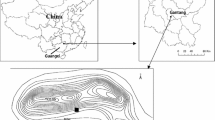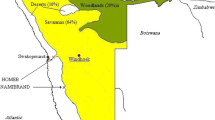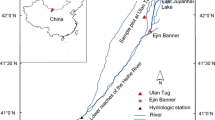Abstract
Adult evergreen Ramón (Brosimum alicastrum Sw. Moraceae) trees can thrive on the shallow soils atop limestone of northern Yucatan despite limited soil water storage capacity, and do not require irrigation during the annual dry season. We hypothesized that early development of deep roots to reach moist subsoil layers or groundwater is critical to the performance of ramón trees growing on thin soils (∼5 cm deep) over limestone bedrock. We conducted an isotopic study in a non-irrigated ramón plantation aimed at determining the sources of water used by trees of different age (5 or 9 years old) at the peak of the dry season. Pit excavation showed that Brosimum alicastrum roots were mostly concentrated in the upper soil and bedrock layers. About 5-year-old trees showed a much sharper decrease in shoot water content (21%) than 9-year-old ones (10%) during the dry season. Foliar δ13C values were significantly higher in 5-year-old trees (−27.5 ± 0.3‰) than in 9-year-old ones (−28.5 ± 0.3‰), indicating greater water use efficiency and water stress levels in the younger age group. The δ18O signature of stem water did not differ significantly between tree age groups at either sampling date. Stem water δ18O values of Brosimum alicastrum trees at the peak of drought (−2.3 ± 0.3/−2.9 ± 0.3‰) were significantly different from groundwater (−4.3 ± 0.1‰) for both age groups. According to δ18O data, ramón trees utilized bedrock water from depths between 0.5 and 2.5 m during the late dry season. Better dry-season water status in 9-year-old trees compared to 5-year-old ones appeared to be more the result of greater volume of soil and bedrock explored for water than the outcome of deeper rooting depth. The ability to take up water stored in the upper few meters of the weathered limestone bedrock during the pronounced dry season is likely the key feature allowing Brosimum alicastrum to thrive under non-irrigated conditions in the shallow, rocky soils of the Yucatan. Locally adapted native tree species capable of efficiently extracting water from bedrock may be the only perennial crops suitable for rainfed cultivation in the shallow soils atop limestone of northern Yucatan.
Similar content being viewed by others
References
Ayala A, Sandoval SM (1995) Establecimiento y producción temprana de forraje de ramon (Brosimum alicastrum Swartz) en plantaciones a altas densidades en el norte de Yucatán, México. Agroforestería en las Américas 7:10–16
Barnes CJ, Turner JV (1998) Isotopic exchange in soil water. In: Kendall C, McDonnell JJ (eds) Isotope tracers in catchment hydrology. Elsevier, Amsterdam
Bautista-Zuñiga F, Estrada-Medina H, Jiménez-Osornio JJ, González-Iturbe JA (2004) Relación entre el relieve y unidades de suelo en zonas cársticas de Yucatán. Terra Latinoamericana 22:243–254
Bradford KJ, Hsiao TC (1982) Physiological responses to moderate water stress. In: Lange OL, Nobel PS, Osmond CB, Ziegler H (eds) Physiological Plant Ecology II. Water relations and carbon assimilation. Encyclopaedia of Plant Physiology (New Series) vol 12B. Springer-Verlag, Berlin
Brunel JP, Walker GR, Kenneth-Smith AK (1995) Field validation of isotopic procedures for determining sources of water used by plants in a semiarid environment. J Hydrol 167:351–368
Burgess SO, Adams MA, Turner NC, White DA, Ong CK (2001) Tree roots: conduits for deep recharge of soil water. Oecologia 126:158–165
Cairns MA, Olmsted I, Granados J, Argaez J (2003) Composition and aboveground tree biomass of a dry semi-evergreen forest on Mexico’s Yucatan Peninsula. For Ecol Manage 186:125–132
Campo J, Dirzo R (2003) Leaf quality and herbivory responses to soil nutrient addition in secondary tropical dry forest of Yucatan, Mexico. J Trop Ecol 19:525–530
Casper BB, Schenk HJ, Jackson RB (2003) Defining a plant’s belowground zone of influence. Ecology 84:2313–2321
Chimner RA, Cooper DJ (2004) Using stable oxygen isotopes to quantify the water source used for transpiration by native shrubs in the San Luis Valley, Colorado USA Plant Soil 260:225–236
Cramer VA, Thorburn PJ, Fraser GW (1999) Transpiration and groundwater uptake from farm forest plots of Casuarina glauca and Eucalyptus camaldulensis in saline areas of southeast Queensland, Australia. Agric Water Manage 39:187–204
Dawson TE, Mambelli S, Plamboeck AH, Templer PH, Tu KP (2002) Stable Isotopes in Plant Ecology. Annu Rev Ecol Syst 33:507–559
Drake PL, Franks PJ (2003) Water resource partitioning, stem xylem hydraulic properties, and plant water use strategies in a seasonally dry riparian tropical rainforest. Oecologia 137:321–329
Duch GJ (1995) Los suelos, la agricultura y vegetación en Yucatán. In: Hérnandez E, Bello E, Levy S (eds) La milpa en Yucatán: Un sistema de producción agrícola tradicional. Colegio de Postgraduados, México
Ehleringer JR, Dawson TE (1992) Water uptake by plants: perspectives from stable isotope composition. Plant Cell Environ 15:1073–1082
Ehleringer JR, Roden J, Dawson TE (2000) Assessing ecosystem-level water relations through stable isotope analyses. In: Sala OE, Jackson RB, Mooney HA, Howarth RW (eds) Methods in ecosystem science. Springer, Berlin-Heidelberg-New York, pp 181–198
Estrada-Medina H (2000) Caracterización y cartografía del recurso suelo del municipio de Hocabá, Yucatán. Tesis de Maestría en Manejo y Conservación de Recursos Naturales Tropicales. Mérida, Yucatán, México
Estrada-Medina H, Graham RC, Allen MF, Jimenez-Osornio JJM (2005) Karstic Features and Tree Root Development in Yucatán, México. ASA-CSSA-SSSA International Annual Meeting, Nov 6–10:Salt Lake City
Ewe SML, Sternberg L, Busch DE (1999) Water use patterns of woody species in pineland and hammock communities of South Florida. For Ecol Manage 118:139–148
Farquhar GD, O’Leary MH, Berry JA (1982) On the relationship between carbon isotope discrimination and intercellular carbon dioxide concentration in leaves. Aust J Plant Physiol 9:121–137
Farrington P, Turner JV, Gailitis V (1996) Tracing water uptake by jarrah (Eucalyptus marginata) trees using natural abundances of deuterium. Trees 11:9–15
Flanagan LB, Ehleringer JR, Marshall JD (1992) Differential uptake of summer precipitation among co-occurring trees and shrubs in a pinyon-juniper woodland. Plant Cell Environ 15:831–836
Gillespie AR, Bocanegra-Ferguson DM, Jiménez-Osornio JJ (2004) The propagation of Ramón (Brosimum alicastrum Sw.; Moraceae) in Mayan homegardens of the Yucatan Peninsula of Mexico. New Forests 27:25–38
González-Herrera R, Sánchez-Pinto I, Gamboa-Vargas J (2002) Groundwater flow modeling in the Yucatán karstic aquifer, México. Hydrogeol J 10:539–552
Gries D, Zeng F, Foetzki A, Arndt SK, Bruelheide H, Thomas FM, Zhang X, Runge M (2003) Growth and water relations of Tamarix ramosissima and Populus euphratica on Taklamakan desert dunes in relation to depth to a permanent water table. Plant Cell Environ 26:725–736
Hubbert KR, Beyers JL, Graham RC (2001) Roles of weathered bedrock and soil in seasonal water relations of Pinus jeffreyi and Arctostaphylos patula. Can J For Res 31:1947–1957
Jackson PC, Meinzer FC, Bustamante M, Goldstein G, Franco A, Rundel PW, Caldas L, Igler E, Causin F (1999) Partitioning of soil water among tree species in␣a Brazilian Cerrado ecosystem. Tree Physiol 19:717–724
Jiménez-Osornio JJ, Ruenes-Morales MR, Montañés-Escalante P (1999) Agrodiversidad de los solares de la península de Yucatán. Red, Gestión de Recursos Naturales 14:30–40
Leffler JA, Enquist BJ (2002) Carbon isotope composition of tree leaves from Guanacaste, Costa Rica: comparison across tropical forests and tree life history. J Trop Ecol 18:151–159
Montañez-Escalante P, García-Barrios L, Jiménez-Osornio J (2005) Quarry reclamation in Mérida, Yucatán, México: a review on achievements and current limitations. Trop Subtrop Agroecosyst 5:101–108
Negreros-Castillo P, De Clerck FA J (1999) Establecimiento de sistemas agroforestales multiestrato. Red Gestión de Recursos Naturales 14:18–21
Orellana R, Balam-Ku M, Bañuelos-Robles I, García E, González-Iturbe JA, Herrera-Cetina F, Vidal-López J (1999) Evaluación climática. In: García de Fuentes A, Córdoba y Ordóñez J, Chico Ponce de León P (eds) Atlas de Procesos Territoriales de Yucatán. Universidad Autónoma de Yucatán, Mérida, pp 163–182
Peters CM, Pardo-Tejada E (1982) Brosimum alicastrum (Moraceae) uses and potential in Mexico. Econ Bot 36:166–175
Rasmussen YD (1990) The effects of light and water stress on Brosimum alicastrum seedlings. Master Sci. Thesis. University of California, Riverside
Rose KL, Graham RC, Parker DR (2003) Water source utilization by Pinus jeffreyi and Actostaphylos patula on thin soils over bedrock. Oecologia 134:46–54
Snyder KA, Williams DG (2000) Water sources used by riparian trees varies among stream types on the San Pedro River, Arizona. Agric For Meteorol 105:227–240
Sternberg LD L, Moreira MZ, Nepstad DC (2002) Uptake of water by lateral roots of small trees in an Amazonian Tropical Forest. Plant Soil 238:151–158
Stewart GR, Turnbull MH, Schmidt S, Erskine PD (1995) C-13 natural abundance in plant communities along a rainfall gradient: a biological integrator of water availability. Aust J Plant Physiol 22:51–55
Stratton LC, Goldstein G, Meinzer FC (2000) Temporal and spatial partitioning of water resources among eight woody species in a Hawaiian dry forest. Oecologia 124:309–317
Tu KP, Brooks PD, Dawson TE (2001) Using septum-capped vials with continuous-flow isotope ratio mass spectrometric analysis of atmospheric CO2 for Keeling plot applications. Rapid Comm Mass Spectrom 15:952–956
Weidie AE (1985) Geology of the Yucatan Platform. In: Ward WC (ed) Geology an hydrogeology of the Yucatan, Quaternary geology of northeastern Yucatan Peninsula. NOGS Publications, pp 1–19
Weisbach C, Tiessen H, Jiménez-Osornio JJ (2002) Soil fertility during shifting cultivation in the tropical karst soils of Yucatan. Agronomie 22:253–263
Yurtsever Y, Gat JR (1981) Atmospheric waters. In: JR Gat, Gonfianti R (eds) Stable isotope hydrology: deuterium and oxygen-18 in the water cycle. International Atomic Energy Agency, Vienna, pp 103–142
Zencich SJ, Froend RH, Turner JV, Gailitis V (2002) Influence of groundwater depth on the seasonal sources of water accessed by Banksia tree species on a shallow, sandy coastal aquifer. Oecologia 131:8–19
Zwieniecki MA, Newton M (1996) Seasonal pattern of water depletion from soil-rock profiles in a Mediterranean climate in southwestern Oregon. Can J For Res 2:1346–1352
Acknowledgements
We thank David Magaña for allowing us to conduct this research in his Kampepén plantation. We also thank Angela López, Season Snyder and Roberto Lepe for their help with laboratory and field work. This research was supported by a UC MEXUS-CONACYT grant awarded jointly by the University of California Institute for Mexico and the United States, and the Mexican Comisión Nacional de Ciencia y Tecnología. We also thank the financial support of the American Institute for Global Change Research (IAI Project: Biogeochemical cycles under land use change in the semiarid Americas). JI Querejeta acknowledges a postdoctoral Fulbright Fellowship from the Spanish Ministerio de Educación y Ciencia, as well as financial support by the Biocomplexity Program (DEB 9981548) of the US National Science Foundation. Finally, we acknowledge the constructive comments of three anonymous reviewers.
Author information
Authors and Affiliations
Corresponding author
Rights and permissions
About this article
Cite this article
Querejeta, J.I., Estrada-Medina, H., Allen, M.F. et al. Utilization of bedrock water by Brosimum alicastrum trees growing on shallow soil atop limestone in a dry tropical climate. Plant Soil 287, 187–197 (2006). https://doi.org/10.1007/s11104-006-9065-8
Received:
Accepted:
Published:
Issue Date:
DOI: https://doi.org/10.1007/s11104-006-9065-8




